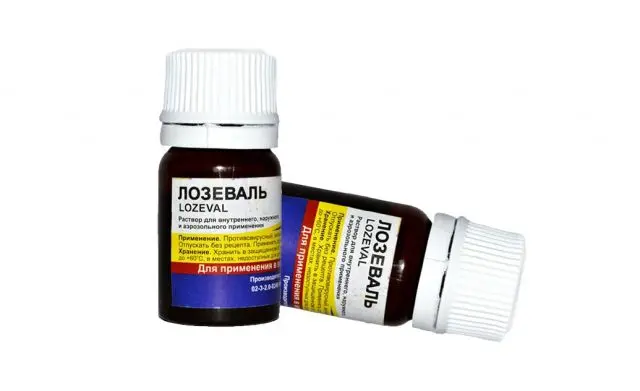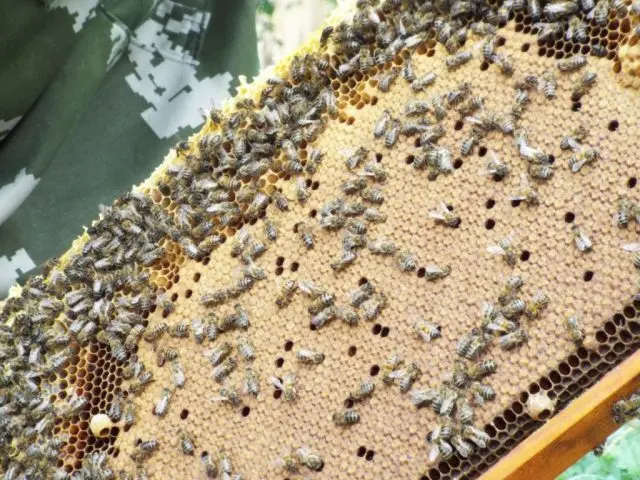Contents
Experienced beekeepers are familiar with situations when, as a result of infection of bees, there is a danger of losing the whole hive. Loseval is a popular antibacterial drug that can help cope with the disease.

Application of Loseval in beekeeping
Loseval for bees can be used both as a remedy and as a prophylactic. It is great for combating the following dangerous diseases that affect insects:
- sacbrood – infection of viral origin, affecting 2-5-day-old larvae and leading to their mass death;
- filamentovirus – a viral infection that affects the DNA of adults and queens, leading to the death of bees on the 7-12th day after infection;
- paratyphoid – an infectious disease of adults, causing a breakdown of the digestive processes, diarrhea and, as a result, leading to the death of bees;
- bee paralysis – a virus that affects the nervous system of young and flying bees, as a result of infection with which insects lose their ability to fly and eventually die;
- various purulent diseases.
Treatment of bees with Loseval as a preventive measure allows you to achieve the following results:
- increase the immunity of bees and disease resistance;
- preventing the development of infectious diseases;
- increase the efficiency of hives by 10-15%.
Composition, form of release
Veterinary preparation Loseval is produced in the form of an oily liquid of a yellowish-brown or orange color, which is packaged in 30-250 ml bottles. The drug has a rather characteristic pungent odor.
The main manufacturer of Loseval is Biostim LLC.
If the drug has a jelly-like consistency, it is likely that the storage rules have been violated, and the loss of useful properties is possible. The use of this drug is not recommended.
The composition of the drug includes the following components:
- triazole (an organic compound of the heterocycle class);
- dimethyl sulfoxide (bipolar aprotic solvent);
- polyethylene glycol;
- morpholinium acetate (preparation-hetaprotector);
- distilled water.

Pharmacological properties of the drug Loseval
The drug, getting on the integument of the insect, successfully penetrates through chitin and enters the tissues and organs of the bee. As a result, the active ingredients that make up the drug begin to fight bacteria and viruses that have infected cells, leading to the death of foreign microorganisms or their significant weakening.
The effectiveness of Loseval in the fight against bee diseases is due to the following factors:
- the drug destroys proteins and nucleic acids of pathogenic viruses and microbes, causing their mass death;
- equally effective against gram-positive and gram-negative bacteria;
- increases the amount of immunoglobulin in the body of the bee, helping to increase resistance to various diseases.
As for the removal of the veterinary preparation from the body, this period is no more than 24 hours. Due to this, the agent does not accumulate in the tissues and organs of insects and does not affect their functioning and the quality of the product produced by bees.
Instructions for use
Instructions for use of Loseval for bees contains a detailed description of the drug and the rules for its use.
It is necessary to remember the safety rules when working with veterinary medicinal products:
- do not eat, drink or smoke at the same time as using;
- after using the drug, wash your face and hands thoroughly with soap;
- it is forbidden to reuse containers from under the drug – they must be disposed of;
- if Loseval gets on the skin or mucous membranes, immediately rinse this place with plenty of water;
- in the event of allergic reactions, you should immediately stop using the drug.
Loseval is suitable not only for the treatment of bees, but can also be used to treat various diseases in poultry and animals.
If we talk about Loseval’s analogues, then only a foreign-made drug, Izatizon, can be noted here. This drug has the same wide range of action and can be used to treat and prevent disease in bees. However, it should be noted that the price of an imported drug is slightly higher.
Also, many beekeepers are concerned about the compatibility of Loseval for bees with Fluvalidez. There is no evidence that the parallel use of drugs is unacceptable.
Dosage, rules for the use of the drug for bees Loseval
For bees, the following dosage of Loseval is recommended: 5 ml of the drug should be diluted in 300 ml of water. The resulting solution must be sprayed three times with an interval of 2 days.
If spraying did not give the desired effect or it turned out to be lower than expected, re-treatment can be carried out no earlier than 5-7 days after the completion of the previous course.
At air temperatures below 18-19 ° C, it is undesirable to spray the hives. At such times, Loseval can be used as an additive to top dressing. With this application, 5 ml of the veterinary preparation is dissolved in 1 liter of syrup. Complementary foods are given in 50 ml per hive 2-3 times a day, not more than 1-2 times a week.

Side effects, contraindications, restrictions on use
No serious contraindications for the use of Loseval in the treatment or prevention of diseases in bees have been noted. Usually, with the timely correct administration of the drug, its high efficiency is noticeable.
The main limitation on the treatment of bee hives with Loseval is related to the temperature regime: it is not recommended to use the drug at temperatures below 18 ° C.
As a preventive measure, spraying is carried out in the spring after the first flight of insects, then after the first extraction of honey and after the end of the harvest season.
Shelf life and storage conditions
The expiration date of Loseval is set by the manufacturer at 2 years from the date of manufacture. It is important to observe the storage conditions so that the drug does not lose its useful properties:
- storage in the original vial;
- protection from direct sunlight and moisture;
- storage separately from foodstuffs;
- storage temperature – 10-35 °C.
Also, these conditions must be strictly observed when transporting the drug.
Conclusion
Loseval is a broad-spectrum veterinary drug that can help in the fight against many dangerous diseases that affect the bee hive. Timely prevention using this tool allows you to increase the immune strength of insects, improve their resistance to infections.










